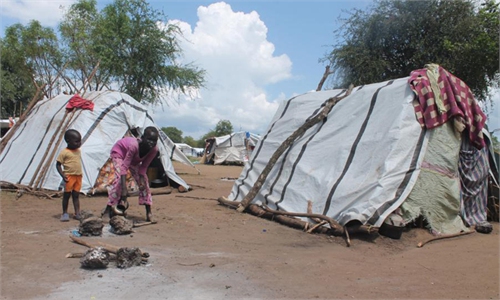
Cholera is an acute diarrhoeal disease caused by the bacterium Vibrio cholerae. Photo: VCG
All the students living in the same dormitory building at Wuhan University in Central China's Hubei Province, where a student infected with cholera, were freed from lockdown management at 9:30 pm on Tuesday, according to a post on the university's official Sina Weibo account on Tuesday night.Wuhan University in Central China's Hubei Province discovered a cholera case on Saturday, the local center for disease control and prevention (CDC) confirmed on Monday morning, specifying that after treatment the patient has greatly improved and the symptoms have disappeared. No other cases have been found so far, the local CDC added.
While COVID-19 outbreaks are not over in China and the flu has hit provinces in South China, the newly found cholera case has sparked public worries.
"There's no need for panic," Yang Zhanqiu, deputy director of the pathogen biology department at Wuhan University, told the Global Times on Monday. Yang confidently stated that with largely improved sanitary conditions and medical treatment, cholera in China has been under control since 2000 and only sporadic cases have been reported in recent years. China can provide advanced medical treatment and efficacious medicines against the disease, thus it is less likely to see a cholera outbreak nowadays, the virologist said.
On Saturday evening, Wuhan CDC received a report from a local hospital of a case of infectious diarrhea in a postgraduate student at Wuhan University. The patient showed symptoms of vomiting and diarrhea accompanied by fever on Friday morning. The student had a history of gastroenteritis, Wuhan University said at a press conference on Monday.
After reviews by the provincial and city CDCs, tests showed the patient was positive for the O139 type of bacteria that causes cholera, while the virulence gene of the case was negative.
After effective diagnosis and treatment, the patient has become stable and his symptoms have disappeared, said the local CDC. The patient was transferred to the People's Hospital of Wuhan University for treatment in isolation, the Wuhan University said on Monday.
The health authority in the city's Wuchang district organized professional institutions to sample, test, track and manage all personnel linked with the case, as well as temporarily seal, disinfect and check all areas connected with the patient.
As of Sunday evening, no new cases were found through rapid detection of 264 connected people, Wuhan University said at Monday's press conference.
All the students living in the same dormitory building with the cholera case have received anal swab tests, the district health commission said.
Cholera is an intestinal infection that can be effectively prevented and treated, said the local CDC.
The health authority of Wuchang district instructed Wuhan University to strengthen the management of its campus environment and promote health education on the prevention and control of infectious intestinal diseases among teachers and students this summer.
The local health authority called on the public to pay attention to personal hygiene, self monitor their health and avoid being misled by rumors.
Given that cholera infection usually occurs in coastal areas, why was this case found in Central China's Wuhan? asked Zhang Zuofeng, chair of the Department of Epidemiology at the UCLA Fielding School of Public Health, in a post on Sina Weibo on Monday.
Zhang said cholera usually occurs in rural areas with poor sanitation and universities should not be a source of cholera. According to Zhang, this case may have been caused by infected students or their families returning to school from rural areas, by eating contaminated raw fish transported from infected areas or by drinking water contaminated with the vibrio cholera bacteria.
The epidemiologist noted that the anal swab testing is not always accurate and may result in false positives. Zhang said detection of cholera infection is typically performed by rapid test analysis and genetic sequencing from stool or vomit samples. Anal swab testing may not be very sensitive, or may not be sufficiently analyzed due to insufficient sample size.
Cholera is a kind of severe intestinal infectious disease which is extremely harmful, can spread rapidly and affect a wide range of people, Zhang said. Vibrio cholerae can spread massively through the water system and cause infection. After infection, if treatment is delayed or inappropriate, severe dehydration can lead to death within a short time, the expert said.
At present, cholera is listed as the most dangerous class-A infectious disease in China. Cholera is mainly found in the coastal areas of China and mainly occurs in the hot summer season, Zhang noted.
There are only two class-A infectious diseases in China - plague and cholera. COVID-19 is class-B, Zhang said
Yang Zhanqiu said that with the exception of 2005, when cholera outbreaks occurred in the southeastern coastal areas of China, most other years since 2000 have only seen sporadic cases of cholera.
According to data previously released by China's National Health Commission, five cases of cholera were reported nationwide in 2021, with no deaths. In 2020, 11 cases of cholera were reported nationwide, also with no deadly outcomes.
Zhang explained that China provides an effective cholera vaccine, but he specified that individuals should wait 15 days between taking a COVID-19 vaccine and the cholera vaccine.
During the 19th century, cholera spread across the world from its original reservoir in the Ganges delta in India. According to the WHO, the world is still within the seventh cholera pandemic and nowadays there are 1.3 to 4 million cases of cholera, with 21,000 to 143,000 deaths worldwide every year.
The key to preventing cholera outbreaks is to identify possible sources of contamination like drinking water and food, said the epidemiologist. The establishment of reliable drinking water and sanitation facilities is critical to combating the spread of cholera and other waterborne diseases, Zhang noted.


